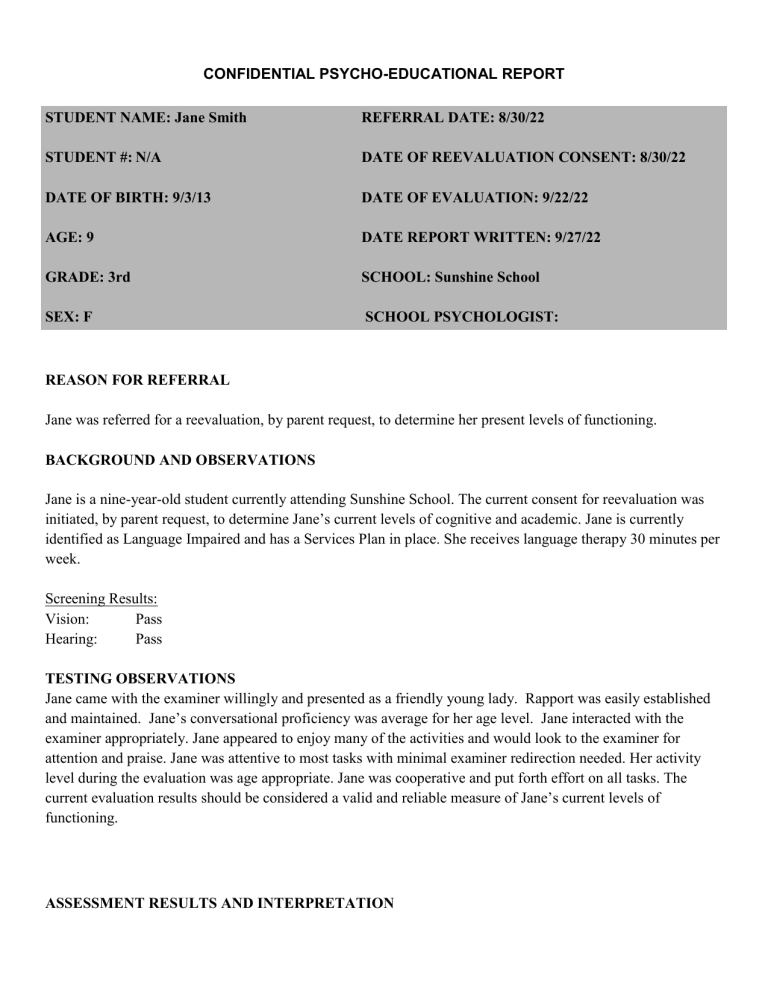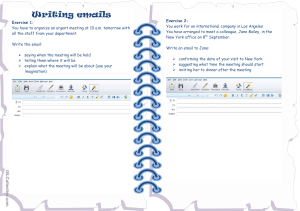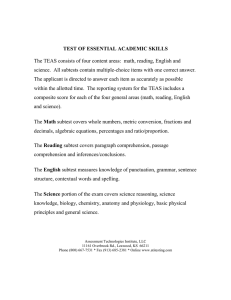
CONFIDENTIAL PSYCHO-EDUCATIONAL REPORT STUDENT NAME: Jane Smith REFERRAL DATE: 8/30/22 STUDENT #: N/A DATE OF REEVALUATION CONSENT: 8/30/22 DATE OF BIRTH: 9/3/13 DATE OF EVALUATION: 9/22/22 AGE: 9 DATE REPORT WRITTEN: 9/27/22 GRADE: 3rd SCHOOL: Sunshine School SEX: F SCHOOL PSYCHOLOGIST: REASON FOR REFERRAL Jane was referred for a reevaluation, by parent request, to determine her present levels of functioning. BACKGROUND AND OBSERVATIONS Jane is a nine-year-old student currently attending Sunshine School. The current consent for reevaluation was initiated, by parent request, to determine Jane’s current levels of cognitive and academic. Jane is currently identified as Language Impaired and has a Services Plan in place. She receives language therapy 30 minutes per week. Screening Results: Vision: Pass Hearing: Pass TESTING OBSERVATIONS Jane came with the examiner willingly and presented as a friendly young lady. Rapport was easily established and maintained. Jane’s conversational proficiency was average for her age level. Jane interacted with the examiner appropriately. Jane appeared to enjoy many of the activities and would look to the examiner for attention and praise. Jane was attentive to most tasks with minimal examiner redirection needed. Her activity level during the evaluation was age appropriate. Jane was cooperative and put forth effort on all tasks. The current evaluation results should be considered a valid and reliable measure of Jane’s current levels of functioning. ASSESSMENT RESULTS AND INTERPRETATION Assessments Administered: Wechsler Intelligence Scales for Children V Wechsler Individual Achievement Test 4 Cognitive Functioning The Wechsler Intelligence Scale for Children – Fifth Edition (WISC-V) is an individually administered, comprehensive clinical instrument for assessing the intelligence of children ages 6 years 0 months through 16 years 11 months. The WISC-V provides primary index scores that represent intellectual functioning in specified cognitive areas (i.e., Verbal Comprehension Index, Visual Spatial Index, Fluid Reasoning Index, Working Memory Index, and Processing Speed Index), a Full Scale IQ that represents general intellectual ability, and ancillary index scores (Nonverbal Index, General Ability Index). These scores have a mean of 100 and standard deviation of 15. The individual subtests scores that in various combinations form the global and index scores have a mean of 10 and standard deviation of 3. The Full Scale IQ is based on a combination of seven subtest scores. Jane’s general cognitive ability falls in the Average range (SS=99) as measured by the FSIQ and is equal to or higher than 47% of her same age peers. The Verbal Comprehension Index is designed to measure a child’s ability to access and apply acquired word knowledge. Jane’s verbal reasoning abilities fall in the Average range (SS=103). The Similarities subtest examined her ability to abstract meaningful concepts and relationships from verbally presented material. Jane was required to respond orally to a series of word pairs by explaining how the words of each pair are alike. On the Vocabulary subtest, she was required to give definitions for words the examiner read aloud. This subtest is designed to measure word knowledge and verbal concept formation. The Fluid Reasoning Index is designed to measure the child’s ability to detect the underlying conceptual relationships among visual objects and to use reasoning to identify and apply rules. Jane’s fluid reasoning abilities fall in the Average range (SS=103). Matrix Reasoning required Jane to look at an incomplete matrix and select the missing portion from five response options. The subtest is designed to measure fluid intelligence, broad visual intelligence, classification and spatial ability, knowledge of part-whole relationships, and simultaneous processing. Figure Weights requires the child to apply the quantitative concept of equality to understand the relationship among objects and then use the concepts of matching, addition, and/or multiplication to identify the correct response. The subtest measures quantitative fluid reasoning and induction. A relative weakness was noted on the Digit Span subtest. Digit Span is a measure of verbal working memory. Verbal working memory involves the ability to register, maintain, and manipulate auditory information in conscious awareness, which requires attention and concentration, as well as auditory discrimination. Verbal Comprehension Subtest Score Summary Subtest Similarities: verbal reasoning & concept formation Scaled Score 10 2 Vocabulary: word knowledge & verbal concept formation 11 Fluid Reasoning Subtest Score Summary Subtest Scaled Score Matrix Reasoning: visual information processing & abstract reasoning skills 10 Figure Weights: quantitative reasoning skills and understanding visual relationships 11 Visual Spatial Subtest Score Summary Subtest Block Design: ability to analyze & synthesize abstract visual stimuli Scaled Score 8 Working Memory Subtest Score Summary Subtest Digit Span: auditory short-term memory, sequencing, attention, & concentration Scaled Score 6 Processing Speed Subtest Score Summary Subtest Coding: processing speed, visual-motor coordination, visual scanning & cognitive flexibility Scaled Score 13 3 Composite Scale Standard Score Percentile Rank Confidence Interval (90%) Classification Verbal Comprehension 103 58 96-109 Average Fluid Reasoning 103 58 97-109 Average Full Scale IQ 99 47 94-104 Average Standard Score 130 and above 120 to 129 110 to 119 90 to 109 80 to 89 70 to 79 69 and below Classification Extremely High Very High High Average Average Low Average Very Low Extremely Low Academic Achievement Academic achievement levels can be determined by sampling a student’s skills in academic subject areas on a standardized test and comparing his or her performance to a national sample of students his or her own age. 4 Jane was tested with selected subtests from the Wechsler Individual Achievement Test, 4th Edition. The WIAT-4 Achievement Battery is a comprehensive battery of individually administered tests measuring the academic achievement areas of reading, oral language, mathematics, and written language. Jane’s performance on the WIAT-4 Achievement Battery is referenced to her age peers. Standard Scores reported have a mean of 100 and standard deviation of 15 points. The range (standard error of measure, SEM values) around each standard score illustrates “error measurement” or the amount of statistical imprecision occurring in that score. The Percentile Rank is a score that describes an individual’s functioning on a scale of 1 to 99. It presents a statistical ranking relative to a comparison peer group (i.e., age or grade peers, depending upon the norm reference that was chosen). The subject’s percentile rank indicates the percent of the peer group that had the same or lower scores as the subject’s scores. This score is useful for describing a person’s relative standing in the population reflecting age or grade peers. Reading Composite On the Reading Composite Jane’s overall reading skills fell into the Very Low range. She obtained a standard score of 79 with a percentile rank of 8%. The Reading Composite consists of Word Reading and Reading Comprehension. Jane stated that reading was hard for her. Her reading was slow and labored. She had to sound out most words which affected her fluency and comprehension. The Word Reading subtest required Jane to read regular and irregular words. This subtest provides an untimed measure of letter and letter-sound knowledge and single-word decoding. Jane scored in the Very Low range, with a standard score 75 and the same or better than 5% of her same age group. For Reading Comprehension, Jane was asked to read passages appropriate to her grade level and then respond to comprehension questions. Early items required Jane to match pictures with words to demonstrate comprehension. Sentence-level comprehension items required Jane to read a sentence then answer a literal question about it. To measure passage comprehension, Jane read narrative and expository passages and answered literal and inferential comprehension questions asked by the examiner. She scored in the Low Average range, with a standard score of 87 and better than 19% of her age peers. Composite/Subtest Letter & Word Standard Score Percentile Rank 90% Confidence Interval Descriptive Category 75 5 72-78 Very Low 5 Recognition Reading Comprehension 87 19 79-95 Low Average Reading Composite 79 8 73-85 Very Low Math Composite Jane obtained a standard score of 93 on the Math Composite. This places her in the Average range with a percentile rank of 32%. The Math Composite is derived from the subtests of Math Problem Solving and Numerical Operations. The Math Problem Solving subtest focuses on reasoning and mathematical concepts and their application to meaningful problem solving. Jane was required to point to pictures or to respond orally to items that required the application of mathematical principles to real-life situations. Jane’s score fell into the Average range, standard score 96, percentile rank 39%. Jane’s skills on the Numerical Operations subtest fell into the Average range, standard score 91, percentile rank 27%. The Numerical Operations subtest measures math calculation skills. For early items, examinees respond orally to questions about number concepts and counting. For later items, examinees write answers to printed math problems ranging from basic operations with integers to geometry, algebra, and calculus problems.Jane was able to perform addition and subtraction appropriate for her age level. She struggled with multiplication facts. Composite/Subtest Standard Score Percentile Rank 90% Confidence Interval Descriptive Category Math Problem Solving 96 39 89-103 Average Numerical Operations 91 27 83-99 Average Math Composite 93 32 88-98 Average Written Expression Jane obtained a standard score of 86 on the Written Expression Composite. This places her in the Low Average range with a percentile rank of 18%. The Written Expression Composite is derived from the subtests of Spelling and Sentence Composition. The Spelling subtest measures written spelling from dictation. Examinees write words that are dictated within the context of a sentence. Jane’s Spelling skills are within the Very Low range, standard score 77, percentile rank 6%. 6 The Sentence Composition subtest is designed to measure sentence formulation skills. Responses are scored based on semantics, grammar, capitalization, and the use of internal and ending punctuation. It includes two component scores: Sentence Building: Examinees write sentences that each include a target word; Sentence Combining: Examinees combine the ideas from two or three given sentences into one sentence. Jane obtained a standard score of 101 placing her in the average range with a percentile rank of 53%. Subtest Standard Score Percentile Rank 90% Confidence Interval Descriptive Category Spelling 77 6 72-82 Very Low Sentence Composition 101 53 92-110 Average Written Expression 86 18 80-92 Low Average SUMMARY AND RECOMMENDATIONS Jane is a nine-year-old student attending Sunshine School School. The results of this evaluation indicate that Jane’s overall cognitive ability is average (SS=99). Her overall reading skills are very low. Her written expression skills are below average, while her overall math skills fall within the average range. It is recommended that Jane’s homeschool convene an IEP Team meeting to review all assessment data from this evaluation and previous evaluations. Upon completion of this review, the committee should determine the most appropriate educational recommendations for Jane given her levels of overall performance. The following recommendations are presented for your consideration, as appropriate: ● Present one instruction at a time. ● Stand near and look directly at Jane when giving directions. If needed, place a hand on her arm or shoulder. ● Ask Jane to paraphrase instructions or to repeat the directions to the teacher before beginning an assignment. ● Write specific directions and assignments on the chalkboard for Jane to copy or provide her with specific written directions. ● Seat Jane near the front of the class to reduce distractions or at a location as least distracting as possible. ● Provide practice for the student in retelling events or stories. For example, read Jane a short story and ask Jane to repeat the events in sequential order or to identify the major story components. ● Use visual aids combined with verbal instruction whenever possible. For example, when giving directions or explaining terms, point to the area of the page or board that contains the relevant 7 information. For many students, added visual, tactile, and contextual input enhances auditory recall ability. Write key terms on the board when giving directions. ● Teach specific memory strategies and techniques that will improve immediate recall, such as the use of verbal rehearsal, grouping or chunking of information, making visual images, and mnemonics. The memory strategies should be taught within a context for which they may be used. 8




